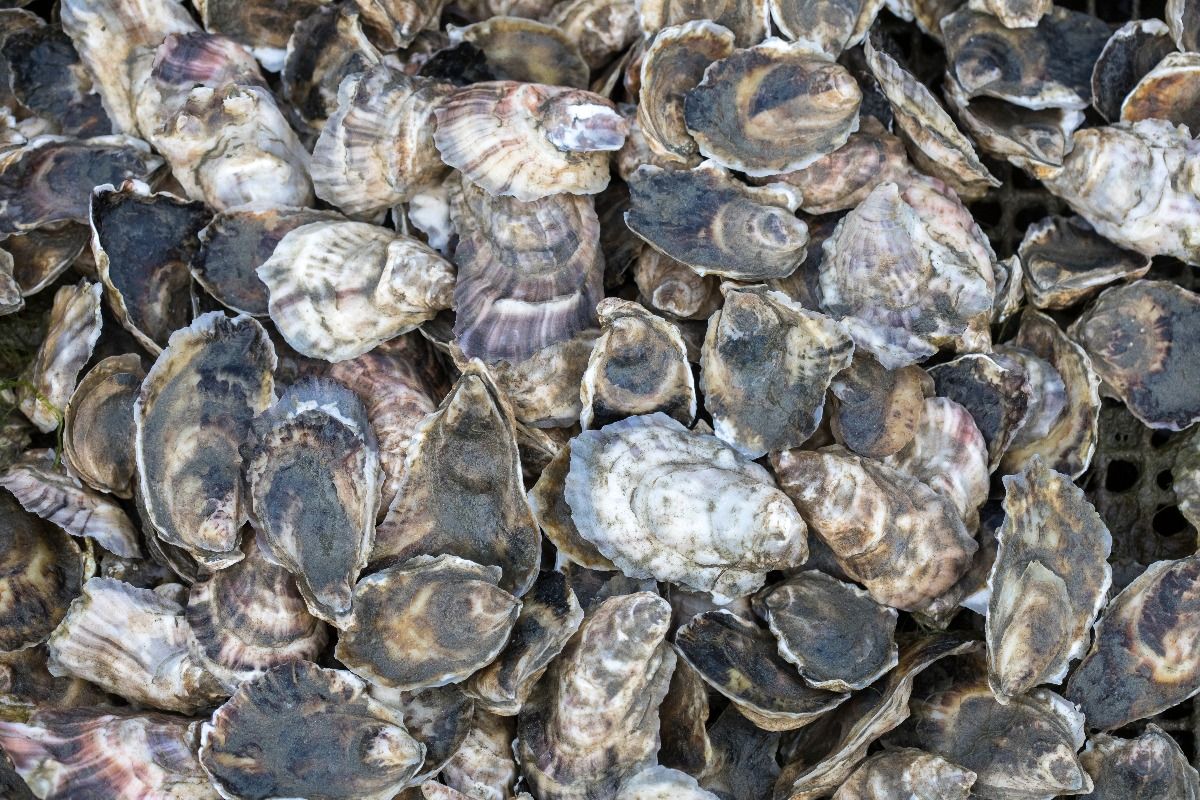Six generations ago, Europe's seas possessed vast oyster reefs. Oysters were found in their millions, clustered together in reef systems that spanned hundreds of square kilometers. Now the reefs are gone and with them, our collective understanding of what the sea used to look like.
Throughout the 1800s and probably earlier, each August would bring Oyster Day: when the bustling streets of London were lined with stalls selling oysters. Children would build grottos from the shells and pester passers-by for pennies for their efforts, with cries of "Pray remember the grotto!". This cultural tradition, and the reefs that enabled it, are now long forgotten.
Nonetheless, European flat oysters (Ostrea edulis) occupy a place in our history. Ancient Roman writings mention oyster farms off the coast of Italy and trade for oysters occurring as far north as Scotland. Oysters were beloved by the aristocracy at the same time as they provided protein for the very poorest. Their bounty inspired festivals, poems and art.
As demand for oysters grew during the industrial revolution, fisheries expanded and oysters were stripped from further afield to feed the rapidly growing urban market. Young oysters were traded internationally to prop up failing fisheries nearer big cities, leading to the misconception that the supply was stable. Some newly discovered beds were eradicated within weeks.
Fishers and government authorities were already worried about declining oyster populations by the early 1800s. A century later, wild populations had collapsed and, today, European oysters are hard to find outside of upmarket restaurants. The weathered shells that are sometimes found on beaches are usually hundreds or even thousands of years old – a faint ghost of the oyster reefs that used to lie beneath the waves nearby.
Oysters everywhere
The catastrophic decline in oyster landings has been well reported. For example, around the east coast of Scotland near Edinburgh, over 30 million oysters a year were landed in the 1830s. Just half a century later, landings had declined to less than 300,000 a year, and by the 1950s, oysters were declared locally extinct. This trend was repeated in coastal locations around Europe and today, only a handful of wild fisheries remain.
Less widely recognized is the massive loss of oyster habitat that accompanied these declines. Europe's seafloor is now largely dominated by shifting sand and mud, interspersed with rocky boulders covered in kelp, and occasional seagrass patches.
It is hard to imagine that hundreds of square kilometers were once covered by large shell reefs composed of millions of living and dead oysters, emerging vertically from the seabed and extending several hectares along the seafloor. Yet our historical research shows this was the case.
From published sources spanning 350 years, the team of 37 researchers documented more than 1,000 locations where oyster fisheries and habitat once existed. Extensive reefs occurred along the coasts of France, Denmark, Ireland and the UK, as well as parts of the Mediterranean and Black Sea.
Written records in government reports, early scientific studies, the writings of naturalists and newspaper articles describe reefs averaging 30 hectares (around 50 football pitches) in size, and rarely being smaller than one hectare (about the size of London's Trafalgar Square).
In the southern North Sea between the UK and the Netherlands, reefs occurred over hundreds of kilometres. These reefs were so full of oysters that they were a noted concern for sail trawlers, who risked breaking their fishing gear on the heavy clumps of shell.
Although information on the size of reefs was available for only a quarter of the historical reef locations, our sources collectively described more than 1.7 million hectares of oyster reef – an area larger than Northern Ireland. These reefs in turn supported vibrant communities of invertebrates, fish and marine mammals.
Restore the reefs
Today, there are no native oyster aggregations that we know of in Europe bigger than a tenth of a hectare, and most wild populations exist at densities lower than one oyster per square meter.
The complex, diverse ecosystem created by European reef-building oysters has collapsed, according to the recent assessment we submitted to the International Union for the Conservation of Nature, which collates the statuses of ecosystems and species.
As well as the loss of cheap, nutritious food and coastal livelihoods, the disappearance of large oyster reef structures will have had huge and unknown ramifications for biodiversity, shoreline protection, water filtration, sediment stabilization and wider fisheries.
Fortunately, coastal communities around Europe are increasingly engaged in the effort to restore native oysters at scale. This typically involves reintroducing oysters and placing shells for remaining oyster larvae to settle on. As seen in other regions where oyster reefs have been brought back, habitat restoration restores the benefits of formally vibrant ecosystems.
Rediscovering the fact that oyster reefs were once extensive and abundant matters. We now know modern definitions of healthy oyster habitats, which cite more than five oysters per square meter and reefs only a few meters wide, actually reflect an impoverished state. While these remnant patches are important and need protecting, our historical findings should urge us to be more ambitious in restoring the seafloor.
We have far to travel to achieve healthy seas, but we also have a blueprint for a brighter future. Native oyster reefs that were once a dominant feature of European seabed habitats could become this again.
"Pray remember the grotto!"

Don't have time to read about climate change as much as you'd like?
Get our award-winning weekly roundup in your inbox instead. Every Wednesday, The Conversation's environment editor writes Imagine, a short email that goes a little deeper into just one climate issue. Join the 40,000+ readers who've subscribed so far.
Ruth H. Thurstan, Associate Professor in Marine and Historical Ecology, University of Exeter and Philine zu Ermgassen, Postdoctoral Researcher in Zoology, University of Edinburgh
This article is republished from The Conversation under a Creative Commons license. Read the original article.



Shares